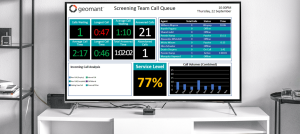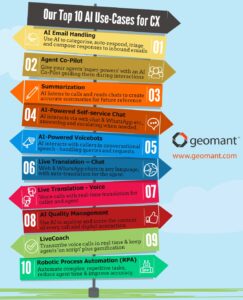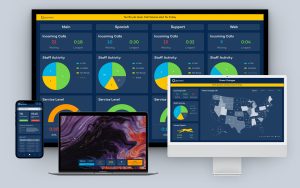Remote contact centers are the future of brand/consumer communications.
Since the pandemic of 2020, companies have discovered that flexible contact centers in the cloud are more than just a solution for boosting productivity and reducing costs. In unpredictable times, being able to support a remote or hybrid workforce ensures business continuity.
The challenges of the pandemic pushed many companies to start experimenting with remote contact centers on a wider scale than ever before. The result was clear evidence that these environments can offer better cost savings, improved scalability, and enhanced agility for all businesses.
However, we also discovered a series of new challenges organizations need to address before they can unlock the full benefits of the remote workforce.
Here are the biggest remote contact center challenges today, and how you can overcome them.

Challenge 1: Unsuitable Equipment
The first challenge companies face in taking their contact center into the future of remote work, is making sure they have the right technology in place to enable ongoing productivity.
Work-from-home agents won’t necessarily be able to switch on a laptop and start responding securely to customer queries. Slow home connections, lack of VoIP connectivity, and poor security are all common problems.
Lack of access to the right technology means that your employees are more likely to spend their time struggling with technical issues, instead of delivering excellent customer service.
How to overcome this challenge:
The best remote contact center is a custom-built solution designed to address the specific needs of your company, your customers, and your agents. The right solution should build on an environment your employees feel comfortable with (Like Microsoft Teams), and make it easy to track conversations across a range of channels, from Voice and SMS to social media messaging.
A custom-built CCaaS solution designed for your business will feature all of the technology remote employees need to stay efficient, from smart voice and digital routing technology to end-to-end channel management and a complete reporting system for a better view of the customer journey. Ideally, you’ll also get a CCaaS solution that can evolve and scale to suit your company.
As the demands of customers continue to transform, a fully customizable API-first architecture will allow you to make customizations that suit your brand. Your contact center solution needs to be easy to use, extensible, and ready to integrate with the bots, tools, and applications your agents are already using.
Challenge 2: Keeping Agents Connected
Enabling a remote contact center means ensuring your teams have access to technology in the cloud that facilitates conversations anywhere. No matter where your employees are, they need to access the same contact center features, from high-quality audio to IVR, voice assistants, smart routing and call queuing. Crucially, however, it’s not just enabling interactions with customers that business leaders need to think about.
Contact center agents also need to be able to connect with each other to share information, collaborate on complicated problems, and accelerate customer service. Disconnected team members struggle to overcome information silos, feelings of isolation, and an absence of specialist support.
How to overcome this challenge:
Keeping agents connected means building a backend environment for your workers to collaborate with each other wherever they are. A Microsoft Teams Contact Center, for instance, comes with access to a comprehensive set of collaboration tools for contact center agents. These features include everything presence, to show who’s available at any given time, to file and screen sharing, video, and audio conferencing, messaging, and notifications.
Challenge 3: Maintaining Agent Motivation
The contact center environment frequently suffers from high levels of employee churn, prompted by lack of agent engagement. The companies that maintain their employees the longest are often the ones capable of offering a memorable employee experience.
When working away from the contact center, it’s easy for employee motivation and productivity levels to diminish. Team camaraderie begins to suffer due to fewer impromptu chats between workers. Staff members start to lose track of their professional goals and business values.
How to overcome this challenge:
The digital world and CCaaS offer a range of ways to keep staff engaged and motivated. Call center dashboards represent a powerful tool for keeping agents focused on the metrics that matter most to your company. Employees can track their performance in real-time, and even compare their output to their peers.
To help re-create the sense of community among remote and hybrid employees, you could even look into creating competitions and rewarding groups or individuals who achieve the best metrics. You might have awards for the highest volume of first-time resolution calls in one week or rewards for the team that has the highest CSAT score at the end of a month. Dashboards can also be used to issue motivational messages to staff wherever they are.
Challenge 4: Damaged Manager/ Agent Relationships
Managers responding to a growing demand for remote contact centers have to figure out how they can provide the same level of support and guidance to team members when they’re not in the same office space. In today’s fast-paced landscape, it’s not enough for supervisors and managers to wait until the evidence of an employees’ issue shows up in metrics like customer satisfaction score and NPS rating.
The people responsible for leading your teams in this new landscape need to be able to keep their fingers on the pulse of what’s happening with every agent at that moment. More importantly, managers need a way to step in and resolve any problems they see.
How to overcome this challenge:
Dashboards and wallboards can deliver valuable access to real-time information for managers, just as they help employees to keep track of their own performance. At the same time, leading CCaaS solutions can support supervisors by sending instant alerts and notifications when an employee’s performance in a certain metric drops below a certain level.
When managers and supervisors become aware of the issues their team members are having, they also need the option to step in with barge-in and whisper functionality, to either take over a problematic call or guide the staff member through the discussion.
Challenge 5: Security and Compliance Issues
When companies first began the transition into the remote contact center environment, many were scrambling to keep the lights on in the midst of a pandemic. This led to many companies making poor decisions about the collaboration, conferencing, and contact center tools they needed. Security and compliance issues can easily overwhelm a successful CCaaS strategy if you’re not careful.
For any organization planning a long-term strategy for the cloud-based contact center, it will be crucial to ensure that security and compliance requirements are addressed. This means thinking about everything from how you defend employee network connections to how you protect your customer’s personal data.
How to overcome this challenge:
The best way to make sure you’re not overwhelmed by security and compliance issues in your remote contact center is to work with the right contact center provider. A good vendor should be able to build your contact center technology stack around your unique needs, implementing tools like VPNs for secure connections and PCI compliant systems for accepting payments.
Today’s leading contact center offerings can come with certified solutions for things like compliant call recording, so you can rest assured that any information you capture is stored correctly and preserved according to the highest standards.
A great CCaaS solution also gives you high-level control over access and permissions, so you can decide who in your teams should have access to what information.
Challenge 6: Continued Optimization
Finally, for most companies, the transition to the world of remote contact center technology won’t be an overnight migration.
Today’s organizations are still exploring the potential benefits and challenges of a cloud-based environment for external conversations. The best contact center platforms will be the ones that allow your brand to adapt and evolve at the right place.
How to overcome this challenge:
Look for a contact center solution with scalability and agility built in from the ground up. Make sure you can add new channels to your omnichannel customer service strategy at the pace that suits you, and look for both native integrations and API connections to make your service more unique to your needs. At the same time, encourage constant feedback from the people who use your CCaaS system.
Collect information from your supervisors, managers, and agents about the features they like and dislike when working remotely with your CCaaS offering, and implement changes based on the information you collect. The right technology will allow you to make frequent, agile changes that empower your employees, improve your business performance, and delight your customers.
The Remote Contact Center is Here to Stay
The age of the remote contact center has arrived, with companies everywhere looking for more flexible ways to ensure their teams remain productive wherever they are. Although there are challenges to overcome on the path to a more flexible contact center, the right vendor, and a little planning will quickly enhance your digital transformation strategy.











